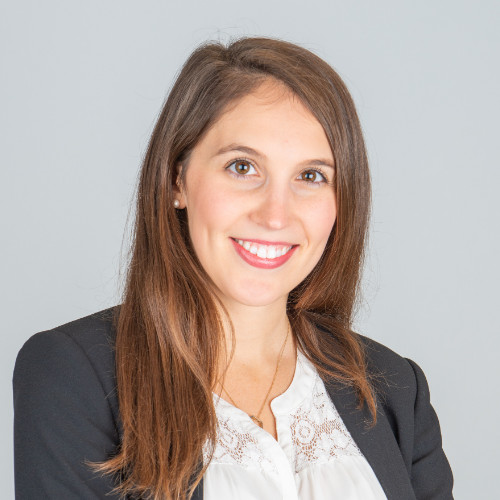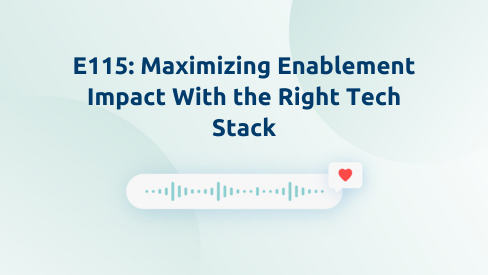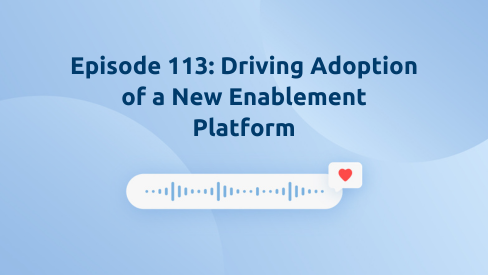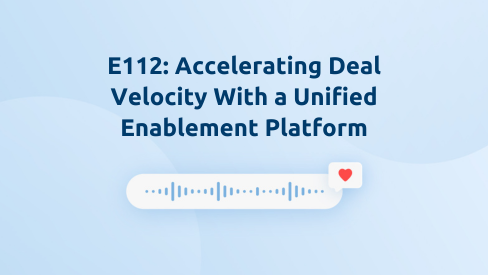Our internal research reveals that since deploying Highspot, customers have seen an average 16% increase in win rate. So, how can you maximize the impact of your efforts with an effective enablement platform?
Shawnna Sumaoang: Hi and welcome to the Win Win Podcast. I’m your host, Shawnna Sumaoang. Join us as we dive into changing trends in the workplace and how to navigate them successfully. Here to discuss this topic is Molly Sestak, the head of enablement at SEDNA.Thanks for joining, Molly! I’d love for you to tell us about yourself, your background, and your role.
Molly Sestak: Thanks so much for having me, Shawnna. I’ve actually been around sales my entire life. My dad’s company is actually a manufacturer’s representative, which basically means they’re the middle people between manufacturers and wholesalers for really large commercial bid jobs. I grew up hearing him on the phone, spending time in the office, hearing how people make calls, and so on. I actually started working there when I was like 15 or 16 until I graduated from university.
The funny thing is I started as the cleaner and all of a sudden one day it was like, oh, can you file a few things? Apparently, I was good at that. I don’t know how you’re bad at filing things, but a few days later my dad’s secretary actually asked me to answer the phones while she was away. Apparently, I was really good at that, so they actually started having me do inside sales. I really was only like 16 or 17, still in high school at this point. I really got my foot in sales early.
I worked there pretty much every summer for five, or six years. I think after uni, I thought I was definitely not going into sales. I didn’t want to be like my dad because all he does is talk on the phone and travel and all sorts, which seems nice, but I didn’t want that. Well, unfortunately, that didn’t work out for me because I found tech and I absolutely fell in love.
I fell into enablement naturally. It was BDR and then became a bit more senior in the team. As we started to build out that team on board new people, I took on that training person role within the team. It started off a little bit ad hoc doing team training and then they’re like, okay you are pretty good at that and I can see you like it, why don’t you help us onboard some of the new joiners? Fast forward a few months later, a job opened up in the enablement team specifically for BDRs, so that’s really where my background focus is. I went for it and never really looked back. I think that really made me realize that I love teaching people how to sell even more so than I actually love selling.
I joined SEDNA about a year ago to help with coaching the sales team, building out playbooks, and so on. It’s definitely been a journey. I think every company has really had quite a lot of hardships in the last year. It pretty much has touched every tech company that I know of. I even did a short stint heading up our BDR team, so a slight shift away from enablement. We’ve finally hired somebody amazing to take over that team so I can announce that I’m finally back into enablement as of about a month ago. I have just been promoted to head of enablement and I’ve never been in that strategic role before. It’s been a really big learning curve, but slowly finding my feet and am excited to see my plans come to life.
SS: Wow. When you say you have been in sales for your lifetime, you really mean from almost start to finish. That’s amazing. I’d love to understand, now that you’re focused on enablement and gravitated towards that, from your perspective, what does good enablement look like? Maybe if I was going to reframe it due to your new role, what are some of the key components of an effective enablement strategy?
MS: I think that’s a really great question, Shawnna. I can of course say what everybody else says in this, I think what the key pillars are, which are content, training, and coaching. I think those are the three key things that we look for in driving enablement in a company. You can create the best programs in the world, but if they aren’t aligned with those company goals and you don’t collaborate heavily with other teams and get those stakeholders bought in, it’s just not going to move the needle. I’ve actually spent some time thinking about this and what I do differently to the above to hopefully help those who are listening out there.
I think one thing that has really helped me is actually having that sales background, doing sales myself. I always bring that into everything that I do, but I also go back to that feeling of being bored in training and not being able to sit still when you have someone talking at you. When I build my programs, one of the things that I try to do is make them as engaging as possible. Does that mean that I’m asking them questions throughout? Do I make it fun? Do I put a game in there? I know when I was at Okta, I actually made a board game called Okta Land. It’s kind of like Candy Land, but it actually was with Okta questions and you had to answer questions about the product or do a cold call role play or handle an objection to move forward on the spaces. So again, it is just how we make it fun and drive that engagement throughout.
I think often as enablement professionals, we get so caught up in that idea of like, we have to have this big strategy. What are we going to do for next year? I’m already thinking about 2024. What’s going to happen? What do we need to leverage to really hit those goals? I think it just turns into that tick-box exercise sometimes. I’ve thought a lot about this recently, which is funny why you’ve asked me this question. I think one of the answers to that is actually having bite-sized training that can influence the now. How do we help people do their jobs better today, not three-quarters from now?
Of course, that’s super important, but we’re already doing that anyway. One of the things I actually just implemented as of last week is called Mondays with Molly. I tried to make it fun with my name, and it’s just in time snackable style enablement. It’s about three to five minutes. It’s a bite-sized video. I’m not a perfect editor, but I just threw it in iMovie and made a little jingle on Canva just to make it a little bit fun. It doesn’t take me very long. I just recorded it right before this podcast and it took me about 20 minutes to come up with the idea and actually record it edit everything and get it ready to send out Monday morning.
The idea is that they listen to it while eating their breakfast or drinking their coffee on a Monday morning in the hopes that that’s something that they’re going to start doing that Monday. That’s what I’ve been doing a little bit differently than the usual enablement strategies that we see all over enablement teams today.
SS: I love it. You have a creative flair that you bring to your enablement strategy to keep it engaging. I mean, attention is a hard thing to capture with sales reps, so kudos to that. How does your enablement platform help you bring that enablement strategy to life?
MS: I definitely couldn’t live without it. I think that’s probably because in enablement we’re constantly faced with this idea of spinning plates and managing multiple stakeholders at one time, there’s like this huge element of collaboration. Not to mention the amount of content that we’re in charge of and making sure that people are actually using and then giving that feedback back into marketing. I’m sure that many of the people listening have just dealt with the sheer number of questions that go a little something like, hey, where can I find X document? I’ve had so many of those questions and to be honest, I made an emoji in Slack, that’s the Highspot emoji, and I just now sent it to them.
It’s kind of a funny way to deal with it, but they do then get used to actually going and finding it themselves. I was absolutely buried in these. Before we had a sales enablement platform, and I really think that they helped bring that structure to the chaos. Besides that, I think the main thing is, first of all, they provide that single source of truth for all the up-to-date content that can be shared with prospects and customers or used internally to inform or upskill the team. Then, not only can you ensure that your team has access to the right content or information at the right time, but they can also share that content with their prospects and customers and get those analytics into what they’re engaging in. Not only does this help enablement, but marketing and reps, it pretty much helps every team that we touch really understand what content is resonating most with buyers. That helps us make much more data-driven decisions over time.
On the training and coaching side of things, It’s a huge manual output. If you don’t have a platform it’s all live sessions, tracking things on Google Sheets. I mean, not to mention if you want somebody to do an accreditation or some sort of certification where they have a role-play involved. It is really difficult to manage all of that with the rubrics and all sorts. This really helps to roll this out and ensure completion on that, those kinds of things like training and certifications or even an onboarding program, for example.
SS: Absolutely. I love that. Those are fantastic examples. Before Highspot, your team leveraged a different enablement platform. Can you tell us a little bit about that experience and maybe some of the challenges that your team faced?
MS: Yeah, absolutely. When I joined SEDNA, the previous enablement team had actually already chosen Seismic, so they had been using it for about eight or nine months by the time I joined. I think before that they were using Google Drive, which is just horrible to think about now that I can’t live without an enablement platform.
SS: Was there an impetus for deciding to make the change and implement Highspot instead?
MS: I think once the team actually got their hands on Seismic, the realization that actually Lessonly in Seismic, they actually weren’t integrated at all. There were two completely separate logins. I think for anybody listening, who’s had to deal with two separate platforms when doing enablement, that’s just double the enablement that you have to do, double the management, and double the admin. That was a huge problem for us.
I think one of the main reasons that we did switch was that I like having content with context. On pages, you have your content and then you have your context, which is your training and coaching around that. You couldn’t really do that with Seismic unless you hacked the page and it was kind of just like a click here type link. There weren’t any buttons. It wasn’t kind of like that smart navigation that you have on other platforms. With the digital sales rooms, they also kind of fell short a little bit, and the team felt that they were really difficult to create and they just weren’t used, even though that was one of the main drivers for purchasing the solution in the first place.
Reps couldn’t find the content. Your platform is only as good as the content that they can find, so it was a huge problem there. That search wasn’t really optimized, and the pages weren’t that easy to navigate. Speaking of the pages, the overall look and feel of the platform just felt a little bit too clunky for a small organization and we really found it difficult to make the lessons and the pages look customized to our brand and the feel of our brand. I think you could have if you had a lot of design experience and had a team dedicated to doing that, but we didn’t. We had to be a little bit scrappy, so that was really challenging.
Then finally, on the analytical side of things, it was really difficult to pull out the data and analytics on what was working and what was being used to really help us make those data-driven decisions. It actually took one of our team members multiple days to pull that data out for QBRs. She really struggled with this and would go to Seismic and ask for help and they would kind of just send her a help article. She’s like I already read the help article like I don’t know how to do this still. We really didn’t get the help that we needed.
On the flip side of things, when I joined SEDNA, I did know that they were already feeling a lot of these challenges, so they were already in talks with Highspot. I think it was basically that our Highspot contact knew that we were coming up on our renewal, and also knew that you guys were launching your Training and Coaching side of things, which was a huge thing for us at the time. The Highspot reached out to my previous boss, like well before renewal, so I think that the Highspot team did a really good job reaching out and being proactive and following up because I really think that that helped us drive the change even further. That was like the nail in the coffin, like, hmm, actually we should look into Highspot again. That was really cool from the team.
SS: Well, I love it, and I’m glad that you’ve joined the Highspot family. After implementing Highspot, how have you been able to solve some of the challenges your team was facing with your previous solution?
MS: I think there were three main things for us that have actually solved a lot of the challenges that I spoke about earlier. The search was a huge win for us. Highspot search is absolutely amazing. I find things in one second. It’s funny because our platform is also renowned for search, so we feel very comfortable with that. Whereas sometimes when you’re searching on other platforms, you don’t really get what you’re looking for and then you have to try to figure out what page is it on. Or what folder did I put it in? This was a huge win for us.
I don’t get any questions about where to find content anymore, so that was a huge sigh of relief for me. Pitching has also been a huge win for us. The team wasn’t really adopting this before, even though it was one of the absolute main reasons we purchased Seismic in the early days. My team absolutely loves that you can add multiple pieces of content in a branded environment rather than just kind of sending those one-off links to each of the pieces of content. That’s been a really big thing for us.
Also just ease of use not only for the team and just how nice the platform looks in general from a UI perspective, but I think from my perspective as an admin. We completed our entire migration, tested it with the team, and rolled it out in literally about two to three weeks. It’s insanely quick. It didn’t feel quick, by the way. It was definitely a bit of a roller coaster for me trying to figure out cause I had never implemented a sales enablement platform before, but we could not have done that with our previous solution. That was huge for us in terms of the admin and upkeep.
SS: To that point, I think getting buy-in from executive leaders on the impact of enablement and the value of your enablement platform is absolutely crucial. What are some of your best practices for securing buy-in from your executive stakeholders?
MS: It’s pretty interesting. I think it’s about getting them to see the value through salespeople. Shouting positive things about it rather than me. I think the second it drives a deal forward or a prospect is like, oh, wow, that’s pretty cool, it definitely will catch their attention. I’m going through Sandler training right now with my new VP and it reminds me a bit of the Sandler Methodology that you have to get your prospect and realistically my sales stakeholders are my prospects and customers, but you almost have to get them to realize it themselves. The impact of something or the challenges they’re having rather than it coming from you. It’s much more powerful.
I think that’s definitely the way to go, almost making them realize like oh, yeah we do have those challenges and wow that actually is a huge impact rather than you saying it yourself. I also, as I mentioned previously, include them up front in the process, and make sure they’re aware and informed throughout because that will really make sure that they’re bought in up front. They know exactly what we’re signing up for and you can already start to have key metrics that you want to measure and make sure that you’re holding yourself accountable for getting the ROI out of that platform.
SS: Absolutely. Now, in addition to having leadership support, you have seen really strong adoption across all of your users. You have a recurring usage rate of 84%. What is your advice for driving adoption amongst your sellers?
MS: It’s really interesting because our team was not really a fan of Seismic. In the beginning, we actually struggled to get people excited about Highspot because they thought it was like, oh, it’s just the same. We kept saying, no, it’s not, but of course, they don’t listen to us. We tell them things all the time. They need to find it out for themselves. What I did was I actually tried a few fun things when we launched it. One of those things was a holiday scavenger hunt where we provided clues that led to the most important pages that we wanted them to land on. Let’s say product or partnerships or personas pages. It helped them get the navigation down and understand where everything was located. We basically put holiday emojis on the piece of content that related to the clue so they had to go and find those.
SS: I love that. Taking those skeptics and making them champions is absolutely clutch. Now, I want to ask because you’ve talked a lot throughout this podcast about the importance of a unified platform that can help you not only with content but also training and coaching and seamless experience is driving adoption. How have you started to leverage Highspot Training and Coaching and what are some of the results that you’ve seen so far?
MS: The first thing that we did with Highspot Training and Coaching was actually a Highspot certification, naturally. That got them used to the features and functions of how to use it and how it was a little bit different than Lessonly, so we got them comfortable with it. Since then, we’ve done quite a lot of certifications. One of which was like a discovery demo certification that included not just some videos and some live sessions, but we actually took it one step further and did a video response with some test questions and had a rubric attached to that, that then matched our rubric in Gong.
When we started to do call coaching later on, that was like the real-world example and not just kind of the role-play example. We could then take that rubric and use that later down the line and they were comfortable with it and familiar with it and knew exactly what they needed to change.
That was the first real instance of using this. We were not able to do this with Seismic. The video uploads never worked for us, so we always had to do things like a manual send via Slack, which is just not ideal. With Highspot, we’re actually able to take the best video responses and I was able to then build a page with all of the best ones where people could then go and watch here’s what good looks like off the back of this. That could be Gong calls, but it could also be the video responses that they’re using.
The next thing that I’m building out is actually an onboarding program for both BDRs and AEs. They join on the second of October, so I actually only have about a week left to be able to build this out, and maybe only 60% of the way. Onboarding just has so much content. I think it’s great that having that kind of platform that has both the content and the training and coaching is an absolute necessity for new joiners because not only do they have a place to go when it’s like oh I finished everything for today for my onboarding. They can go in, they have Gong calls to watch within Highspot, they have different video training that is bite-sized like my Mondays with Molly that they can go watch, they can see QBR decks, they can go kind of peruse product personal information. I think it’s just super helpful for them to have access to that content on day one and just in time when they want to discover it.
On top of that, from my perspective, I can see exactly where they are in their onboarding journey. What have they completed? Pretty much every day they have pre-work, which tends to be like a series of e-learning videos or articles that they need to read, and some live sessions that we’ve run outside of Highspot. Then we throw them back into the platform in the afternoon for their post-work, which could be a presentation that they have to create, and then they need to upload the link into Highspot so we can grade it and give them feedback on it, or an objection handling role play that they need to do. We use test questions a lot, and we also use the free video response a lot.
That just means that as we grow our new joiners and we have people go through onboarding we can start taking best practices and link the videos that they do within that without having to download upload and record them via Zoom. It just makes that way easier. Just having everything in that one unified platform.
SS: I love that. On that note, last question for you, Molly. This has been fantastic by the way. What has been the impact of having a unified platform on sales productivity, and do you have any key wins or business outcomes you can share?
MS: I think getting our top seller on board was a huge key win for us because I think if we didn’t manage to do that, I think we would have been in trouble. That was probably our biggest win of really driving that adoption and making sure that sales are productive with it. We’ve also done some additional things, like refresher training. Some of those will also be coming up on Mondays with Molly. Just little things, like if we get updates in Highspot, I know you guys are always launching new, amazing features.
That Monday with Molly is a perfect outlet to then be like, hey, this is actually something new that you can do on the platform and I want you to start doing it today. I can start measuring that. In general, I don’t get any more questions, like Where can we find X? The search function is working really well. It means that reps can find the content that they need in a matter of seconds, rather than doing the whole waiting for somebody to answer on Slack, which could take hours if not days. If I’m really busy, sometimes I forget to respond.
Actually, there’s a funny story that happened the other day that I think brings us to life. We have a new RevOps contractor who’s doing some territory planning and books of business for us. She actually asked me the question the other day and fair enough I didn’t train her on Highspot and she said, hey, do we have a document on ICP or something like that? I said no, actually we don’t have that document. I need to build it, blah, blah, blah. She said this back to me and I quote, I am glad I’m not crazy. Things are so well organized here that I have to keep reminding myself if you can’t find it, it doesn’t exist.
I thought that was like a true testament to what we’re trying to do with not only the search function but really optimizing that guided selling experience so that if you don’t know where something lives and you’re not really sure exactly what you’re looking for and what it’s called, that you can navigate and kind of discover that content as it comes up and as needed. I think we need to refine that a little bit more moving forward now that we know what people are searching for and updating that content. I think we have a really good, strong foundation to start with and it is clearly working.
Marketing was able to pull out all of the most used external content, which really provided the foundation on which they were able to prioritize which pieces of content they should actually update first. I think that was really helpful for them. We, of course, don’t have a crazy amount of content. I think we have maybe 400 or so assets in the platform, but if you had to go through 400 and try to prioritize, just kind of finger in the wind, that would have taken them a really long time. I think it saved them quite a lot of time on that front.
In saying all of this, I actually wish that we had really concrete and better metrics, but with my role shifting so much, we haven’t really measured enough or properly used the governance side. It’s actually something that’s on my list to work on over the next few months. As part of the refresh, we’re actually going to dive a little bit deeper into some of these and what KPIs we really want to measure moving forward to really make that impact of the platform a lot greater. I am really excited to see where we end up. If I talk to you in a year from now, I think it will be amazing.
SS: I can’t wait. I would love to have you back, Molly. Thank you so much for sharing your story today.
MS: No problem. Thank you so much for having me.
SS: To our audience, thank you for listening to this episode of the Win Win podcast. Be sure to tune in next time for more insights on how you can maximize enablement success with Highspot.




